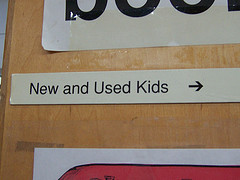Apple, Amazon Looking To Sell Used Digital Content

(KitanaOR)
Amazon was recently granted a patent (filed in 2009) for a “Secondary market for digital objects.”
This application deals with the actual mechanics of how an Amazon customer would purchase something digital — e-book, video, software — that would then be kept in that user’s “personalized data store.”
When that user wants to give up their rights to that item, they could transfer it to the data store of another user. [T]he used digital content is deleted from the originating user’s personalized data store,” reads the patent. After a certain number of transfers, this content would no longer be able to be passed around.
But as PaidContent’s Laura Hazard Owen pointed out in February, “It’s not clear, though, how the system would ensure that a user hadn’t stored a copy of the file somewhere other than his or her ‘personalized data store.’”
Meanwhile, Apple threw its hat into the used digital content ring yesterday by filing a patent application of its own, in which it details techniques for transferring digital content from one user to another, in which “The transferor is prevented from accessing the digital content item after the transfer occurs,” and “only the transferee is allowed access to the digital content item.”
The main difference between Apple’s application and the patent granted to Amazon is that Apple describes how the content creator and/or seller may be given a “portion of the proceeds” of any resale.
Apple outlines a possibility in which “the percentages that each party or entity receives from a resale of a digital content item changes (1) based on the passage of time or (2) based on how many times the digital content item has been resold among end-users. For example, publisher 110 receives (a) 50% on each resale of digital content item 202 that occurs within a year of the initial sale from intermediary 120 to Jeff and (b) 20% on each resale that occurs more than a year after the initial sale. As another example, publisher 110 receives 50% on the first resale (i.e., from Jeff to Sally) and 40% on second resale (i.e., from Sally to another user, not shown).”
In Apple’s system, the passage of a digital item from one person to another would be tracked via embedded DRM.
While we understand the desire to prevent people from making digital copies of their purchased files and selling those off to people without properly paying the copyright holder, we don’t understand the notion that the copyright holder should receive any money from legitimate reselling of purchased content.
In almost all cases of resale of physical items, the original seller or creator receives no additional compensation. If you buy a DVD from Amazon then sell it at a yard sale, you don’t owe Amazon or the studio any money.
If you sell it through Amazon, then yes, Amazon would get a cut because it is fulfilling a function in the resale process. If you make copies and start selling those copies, then yes, you are likely in violation of the copyright, but that is a matter to be proven through legal means.
In our opinion, any system that automatically requires an end-user to share the proceeds of a legitimate resale of digital content with the copyright owner is presuming guilt on the end-user’s part, rather than requiring the copyright holder to prove that they are owed any additional money.
So while we do like the idea of a marketplace for used digital content, we have grave concerns about legitimate resellers being compelled to make payments they otherwise would not have made if they were reselling a physical version of that same item.
Of course, patents are sometimes just pipe dreams and what-ifs, so this may all be much ado about very little.
Want more consumer news? Visit our parent organization, Consumer Reports, for the latest on scams, recalls, and other consumer issues.

